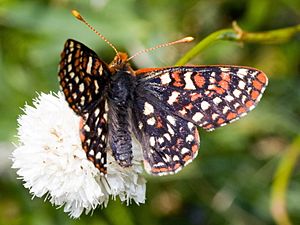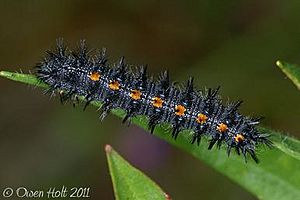Edith's checkerspot facts for kids
Quick facts for kids Edith's checkerspot |
|
|---|---|
 |
|
| In Olympic National Park, Washington state, U.S. | |
| Scientific classification | |
| Subspecies | |
|
See text |
Edith's checkerspot (Euphydryas editha) is a species of butterfly in the family Nymphalidae. It is a resident species of western North America and among the subspecies, entomologists have long been intrigued by their many phenotypic variations in coloration, wing length, and overall body size. Most populations are monophagous and rely on plants including Plantago erecta and Orthocarpus densiflorus as its host species in developing from eggs through to larvae, pupae, and mature butterflies. Males exhibit polygyny whereas females rarely mate more than once. Males devote most of their attention to mate acquisition, and such mate locating strategies such as hilltopping behavior has developed. Climate change and habitat destruction has impacted certain subspecies. Two subspecies in particular, Euphydryas editha quino and Euphydryas editha bayensis, are currently under protection via the Endangered Species Act.
Contents
Description
The Edith's checkerspot can be identified by its wings which are black with red and pale yellow or white bands. It also has a submarginal band that consists of yellow or white spots along with a wide postmedian band that is red. The undersides of the wings consists of alternating bands of yellow orange and cream. The wingspan is 3.2-5.1 cm. However, the subspecies of Edith's checkerspot vary slightly in appearance based on the areas they routinely inhabit. Coastal populations are black with red and cream spots; mountain populations are red or mottled with red, black, and cream spots. The higher-altitude populations are smaller and darker. The larvae of the butterfly are black, spotted with white or orange, or striped with white. The pupae are white or gray, with black blotches and streaks.
Distribution
The Edith's checkerspot is found in North America, where it ranges from southern British Columbia and Alberta south to Baja California, Nevada, Utah, and Colorado. The species can be found in locations of the San Bernardino Mountains, Sierra Nevada, higher Cascade Mountains of Oregon to Washington, and in areas of the Great Basin, including central Oregon and the Rocky Mountains. It can also be found on several trails such as: Animas River Trail, Falls Creek Trail, Colorado Trail, Hermosa Creek Trail, Engineer Mountain Trail, and Spud Lake Trial.
Habitat
Habitats are mountains, typically on ridgetops, from coastal chaparral and transition zone open woodland to alpine tundra. Edith's checkerspot butterflies prefer grasslands and rocky outcrops found in the mountains. They can be frequently found in areas of nutrient-poor, serpentine soils which sustain the native grasslands that they prefer.
Host plants
Edith's checkerspot caterpillars will use various species of paintbrush (Castilleja), beardtongues (Penstemon), lousewort (Pedicularis), owl's clover (Orthocarpus), Chinese houses (Collinsia), and plantain (Plantago) as host plants. Many populations of the butterfly are monophagous and preference for the different plant types are based mainly on location. Many behaviors, such as egg laying habits and movements are locally adapted, so the survival of the butterflies relies heavily on the growing season of these host plants.
Feeding
Populations of Edith's checkerspots use several different hosts to house and feed their pupae. Though they usually do not pollinate the flowers of the host, larvae have been known to eat the leaves, the flowers, and sometimes the entire host plant, and have starved trying to find another. Adult females and females feed on flower nectar. Caterpillars feed on leaves and flowers of the host plant and sometimes surrounding plants.
Life cycle
Oviposition begins within a day of the female's emergence, with females depositing masses of up to hundreds of eggs at the base of host plants. Most populations are monophagous, with females normally ovipositing on only one of several potential host species. Such plants include Plantago erecta and Orthocarpus densiflorus.
The eggs further develop into pre-diapause larvae whose goal is to enter diapause and reach the fourth instar before their annual host plants senesce. Thus, females try to enhance offspring survival by laying egg masses on cool moist slopes where host plant senescence is most delayed. Once the larvae reach the diapause stage and become post-diapause larvae, they must grow by basking in the sunlight to regulate their body temperature. Larval body temperature is about 10-12 °C (18-22 °F) above ambient temperature, and the fastest growth rate occurs at 30-35 °C (86-95 °F). They must receive enough insolation to terminate the diapause stage and become a fully-grown butterfly. Thus, the paradox is that these larvae no longer prefer the cool slopes of host plants they grew up on, as it produces shade to restrict growth.
Predation
Caterpillars in the genus Euphydryas are usually attacked by one to three parasitoid species, often by a species of Apanteles wasp (Braconidae), a species of Benjaminia wasp (Ichneumonidae), and a tachnid fly. Checkerspot butterflies have developed defense mechanisms to prevent predators from attacking. Larvae twitch in unison to repel predators, and, depending on the host plant of the population, the larvae, pupae, and adult butterflies are somewhat poisonous to vertebrates because they may ingest toxins from the plant.
Evolution of protandry
This butterfly exhibits protandry. Males tend to emerge 4–8 days before females do and the average life span of both sexes is 10 days, though it can be as long as three weeks. Protandry may have an effect on the butterfly's mating success in a population. In many time constrained species such as the Edith's checkerspot, early season matings may have a higher probability of producing adults in the next generation than those later in the year. Pre-diapause larvae are under time pressure to mature to diapause size before host plants senesce in summer drought. Therefore, larvae hatching from eggs laid earlier in the season are more likely to have reached the intended size. This is why males mating at the beginning of the season are more likely to produce surviving offspring than males mating a few weeks later.
Conservation status
The Edith's checkerspot subspecies mirror the changes in climate over long periods of time. Global warming is expected to eliminate the butterflies in the south throughout the upcoming years, where the season is becoming shorter and shorter. In areas of the lowest latitude, about three-fourths of the populations have become extinct. This is in contrast to higher latitude areas in Canada where less than twenty percent have disappeared. It has been found that population extinctions were four times as high along the southern boundaries (Baja and Mexico) than along the northern boundaries (Canada). In addition, extinctions are nearly three times as high at lower elevations below 8,000 feet (2,400 m) than at higher elevations from 8,000 to 12,500 feet (2,400–3,800 m). In agreement with global warming predictions, this extinction process has shifted the range of this butterfly both northward and upward in elevation since the 1800s.
In the case of Euphydryas editha quino, habitat destruction is the major reason for its decline, although climate change problems also pose a threat. Quino checkerspot populations along the southernmost boundary (in Mexico) are at the greatest risk from continuing warming and drying climate trends. Unfortunately, these are also the best remaining habitats with the lowest degree of threat from development. By contrast, most Quino habitat has been destroyed by development in the Los Angeles–San Diego corridor. The case of the Quino checkerspot has resulted in the first habitat recovery plan to list climate change not only as a current threat, but also as a factor that should be considered in reserve design and recovery management. Some sedentary checkerspots remain at their original habitats despite the continuation of human interference, and have evolved adaptations to deal with these changes.
In January 1997, the subspecies Euphydryas editha quino and Euphydryas editha bayensis received federal protection under the Endangered Species Act. Euphydryas editha bayensis has also been given the Nature Conservancy global rank of T1, which means that there are very few individuals remaining.
Impact on humans
Edith's checkerspots lay their eggs on various plant species, sometimes resulting in the death of the host plant, which could be potentially economically important to humans. In addition, larvae, pupae, and adults are poisonous to vertebrates if ingested. A plus for humans involves pollination, because in order to obtain nectar, adult butterflies of the species sometimes pollinate various flowers in the area of their habitat.
Subspecies
This species is often better known by the constituent subspecies listed below. It is subject to change as the nomenclature is altered or new subspecies are found.
- Euphydryas editha alebarki Ferris, 1971 – Klots' checkerspot
- Euphydryas editha augusta (Edwards, 1890) – Augusta checkerspot
- Euphydryas editha aurilacus Gunder, 1928 – Gold Lake checkerspot
- Euphydryas editha baroni Edwards, 1879 – Baron's checkerspot
- Euphydryas editha bayensis Sternitzky, 1937 – Bay checkerspot
- Euphydryas editha beani Skinner, 1897 – Bean's checkerspot
- Euphydryas editha bingi Baughman & Murphy, 1998 – Bing's checkerspot
- Euphydryas editha colonia (Wright, 1905) – Colonia checkerspot
- Euphydryas editha editha (Boisduval, 1852) – Edith’s checkerspot
- Euphydryas editha edithana Strand, 1914 – Strand's checkerspot
- Euphydryas editha ehrlichi Baughmon and Murphy, 1998 – Ehrlich's checkerspot
- Euphydryas editha fridayi Gunder, 1931
- Euphydryas editha hutchinsi McDunnough, 1928 – Hutchins' checkerspot
- Euphydryas editha gunnisonensis Brown, 1971 – Gunnison checkerspot
- Euphydryas editha karinae Baughman & Murphy, 1998
- Euphydryas editha koreti Murphy and Ehrlich, 1983 – Koret's checkerspot
- Euphydryas editha insularis Emmel & Emmel, 1974 – Island checkerspot
- Euphydryas editha lawrencei Gunder, 1931 – Lawrence's checkerspot
- Euphydryas editha lehmani Gunder, 1929 – Lehman Caves checkerspot
- Euphydryas editha luestherae Murphy & Ehrlich, 1981 – LuEsther's checkerspot
- Euphydryas editha mattooni – Mattoon's checkerspot
- Euphydryas editha monoensis Gunder, 1928 – Mono Lake checkerspot
- Euphydryas editha nubigena Behr, 1863 – Cloud-born checkerspot
- Euphydryas editha owyheensis Austin & Murphy, 1998
- Euphydryas editha quino (Behr, 1863) – Quino checkerspot
- Euphydryas editha remingtoni Burdick, 1959
- Euphydryas editha rubicunda (H. Edwards, 1881) – Ruddy checkerspot
- Euphydryas editha tahoensis Austin & Murphy, 1998 – Lake Tahoe checkerspot
- Euphydryas editha taylori (Edwards, 1888) – Taylor's checkerspot
- Euphydryas editha wrighti Gunder, 1929 – Wright's checkerspot
Images for kids
See also
 In Spanish: Euphydryas editha para niños
In Spanish: Euphydryas editha para niños



